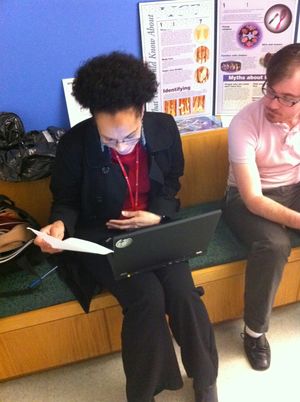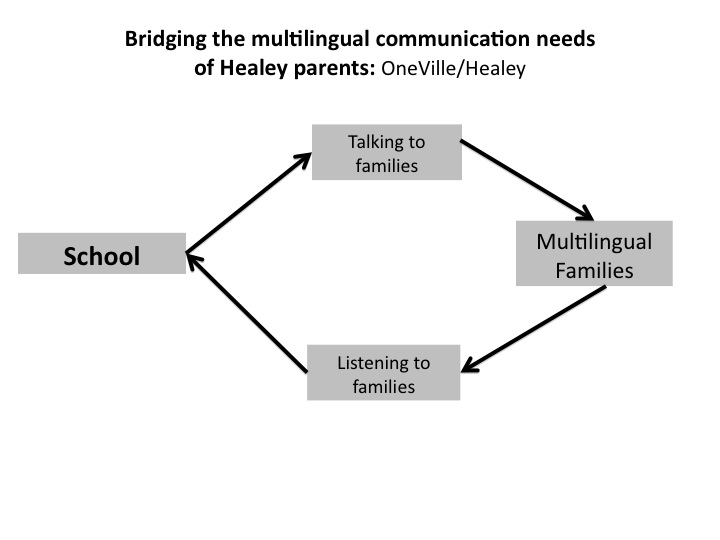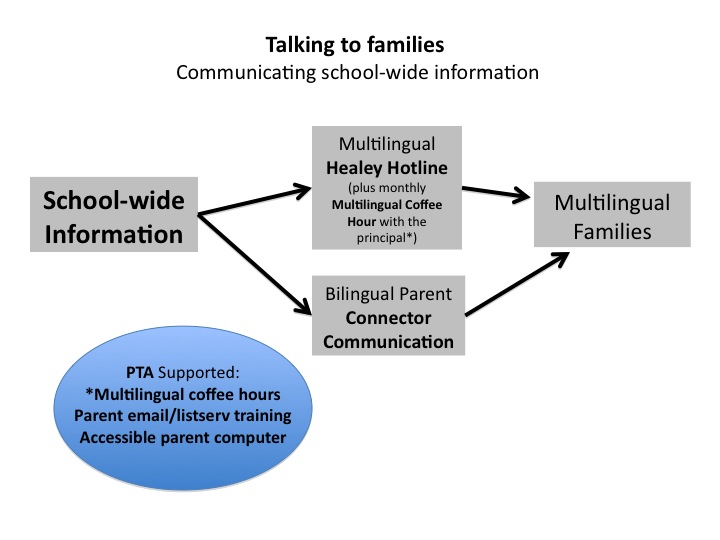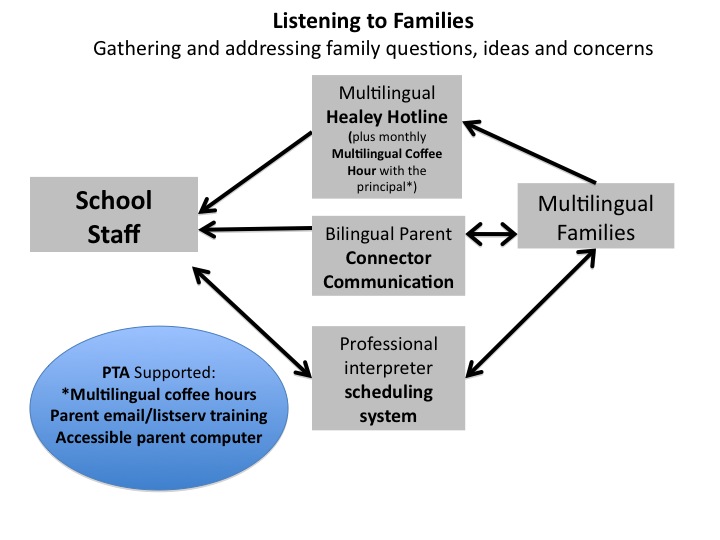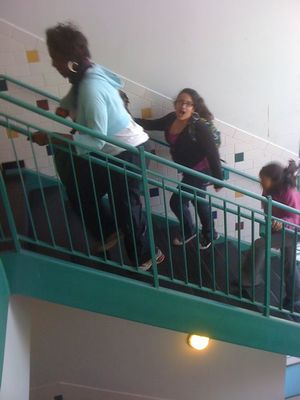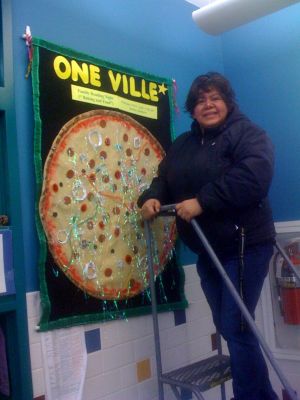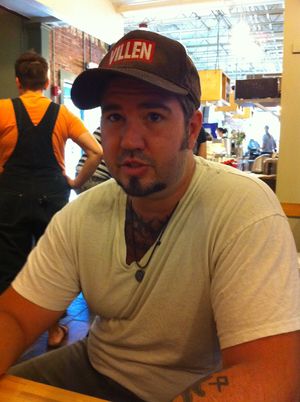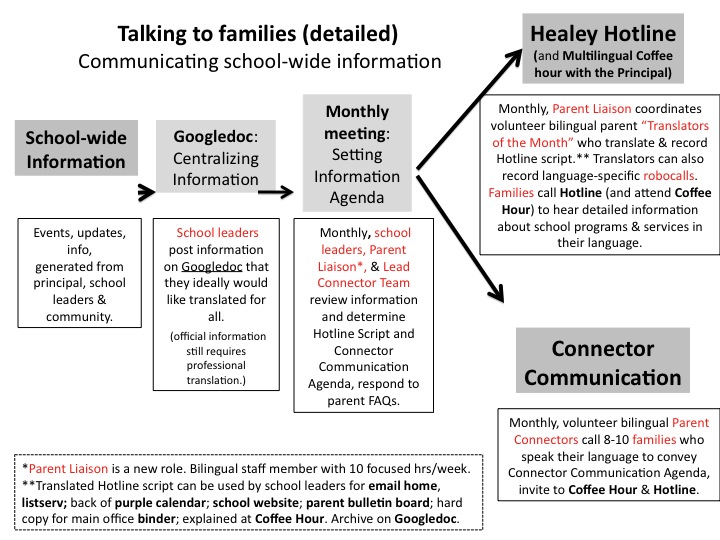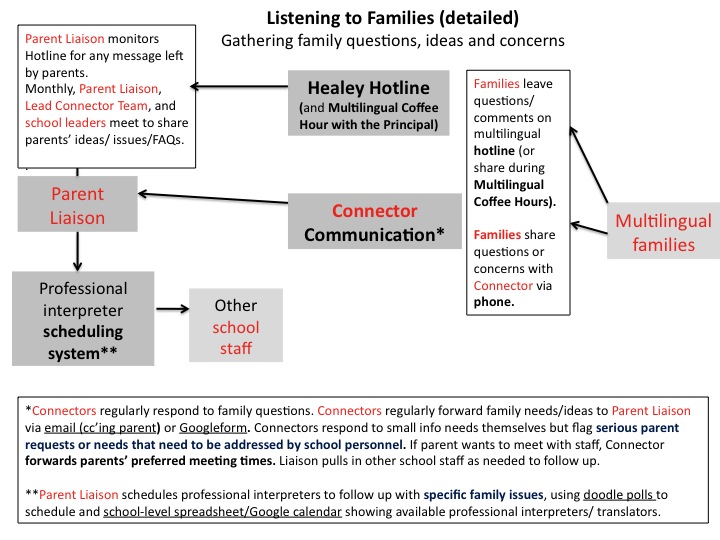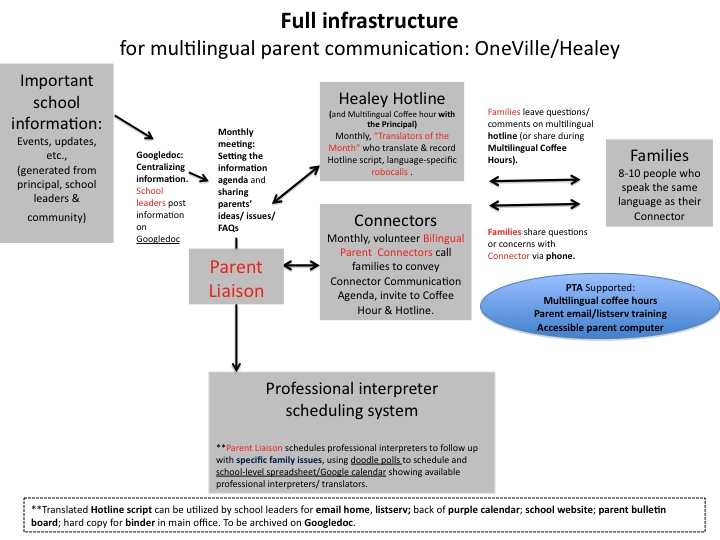Overview and key findings: Schoolwide toolkit/parent connector network: Difference between revisions
From Oneville Wiki
Micapollock (talk | contribs) No edit summary |
Micapollock (talk | contribs) |
||
| Line 43: | Line 43: | ||
2) the sort of systemic communication "infrastructure" necessary to include more immigrant parents as partners in the project of supporting young people. | 2) the sort of systemic communication "infrastructure" necessary to include more immigrant parents as partners in the project of supporting young people. | ||
Our main '''<font color=red>¡Aha!s</font color> over time have been these: | Our main '''<font color=red>¡Aha!s</font color>'''over time have been these: | ||
'''<font color=red>¡Aha!</font color> Along with strong intentions to include all families, diverse schools need systems -- infrastructure -- for getting information to everyone and input from everyone. | '''<font color=red>¡Aha!</font color> Along with strong intentions to include all families, diverse schools need systems -- infrastructure -- for getting information to everyone and input from everyone. | ||
Revision as of 20:14, 16 October 2011
Written by Mica Pollock, Tona Delmonico, Gina d'Haiti, and Ana Maria Nieto for the Parent Connector project, with input from parents across the Healey School and Jedd Cohen
Click here for the Summary on this project; click here for the Expanded story on this project.
Communication we hoped to improve
What aspect of existing communication did we try to improve, so that more people in Somerville could collaborate in young people's success? How’d it go?
- (Who was involved in the project and how was time together spent? What did the project accomplish?)
At Somerville’s Healey School (K-8), as in many U.S. schools, parents hail from across the globe and speak many languages. Language barriers keep parents from being equally informed about school issues, events, and even educational opportunities. So do disparities in tech access, tech training, and time -- as well as gaps in personal relationship and connections. Everyone at the Healey talked about needing better school-home and parent-parent communication, particularly to fully include immigrant families, families without computer access/knowledge, and families who couldn’t or didn’t show up often in person at the school.
So, throughout the schoolwide communication working group, we operated from a central principle already core to the Healey School: a child can’t be educated as effectively if parents aren’t included as key partners in the project. So, schools should ensure access to school information and pull all parents into dialogue about improving their children’s school experience. Info out, input in!
The Healey School enrolls a full U.S. range of families with different communication habits and needs. Some email the principal and Superintendent regularly. Some parents have no computers and no internet. A listserv has long enrolled only some. Robocalls home go in four languages; handouts home often don't. For many, parent teacher conferences require interpreters, and scheduling those interpreters itself is a structural communication need. One Portuguese-speaking dad worked such long hours he didn't even have time to come to school to post a sign saying he wanted to find and pay another parent to help him drive his daughter to school. One Spanish-speaking parent told her Connector she’d been trying for a year to meet with her child’s teacher in person.
In contrast, some families, particularly English-speaking families, volunteer many hours in classrooms during the school day and so get regular access to their child’s teacher. Many such families also are on committees that meet after school and so, take the opportunity then to contribute ideas to the school. Over the years, we saw that families who saw each other regularly at face to face school events also made friends, joined listservs, signed up in directories, and showed up at next events.
As we describe below, we worked on several strategies to support parents to share ideas and information (Reading Nights, Parent Issue Dialogues) and then focused particularly on the challenge of multilingual communication, because language barriers particularly have excluded many Healey parents from full participation. The Multilingual Coffee Hour, begun in 2009, was our first explicitly multilingual effort; then, in 2010-11, the Parent Connector Network has focused fully on reaching out to parents who speak the district's 3 main languages other than English: Spanish, Portuguese, and Haitian Creole. We've also been working to build personal relationships between bilingual parents and recent immigrant parents, in order to bring more voices into school debates and more people into school events and leadership as well as help the school respond more quickly to parent needs.
Begun in Winter 2010, the Parent Connector Network is now a parent-led effort (in partnership with school administrators and staff) to support translation and parent-school relationships, by connecting bilingual parents (“Connectors”) to more recently immigrated parents via a phone tree. The Connectors have come to also use Google forms to gather school information, Google spreadsheets to track calls with parents, and a multilingual hotline we made using free software, to help ensure that information reaches immigrant and low-income families who share the school.
We are currently working with 3 Spanish-speaking, 3 Portuguese-speaking, and 2 Haitian Creole-speaking Parent Connectors. Each Connector is asked to call approximately 10 other families once a month to share key information from the principal/school and to ask questions about any issues parents are facing. The Connectors are also on-call to these parents during the school year to help them find answers to both general and specific questions or concerns they may have about their child’s school. (One Connector also got calls this summer -- about summer school enrollment and about how to reach the district’s Parent Information Center to enroll a new cousin in a school.)
We also innovated the role of volunteer “Translators of the Month” who can help translate school information for a hotline made by local technologists. That translated material can then be used for other school media (listserv, handouts, flyers, etc.).
We also argued for creating a part-time liaison role (five paid hours!) for one staff Connector so that she can respond appropriately to serious or ongoing parent needs -- beyond what a volunteer parent can or should do. She also will help with a key structural issue: scheduling interpreters. We’re piloting the full combination in 2011-12.
Our work, and our ¡Ahas!
What was the basic groundwork needed to support the current work? How did the project change and grow over time? At this point, what are our main ¡Aha!s about improving communications in public education? What communication and implementation ¡Aha!s, and turning points, did we have over time?
As a multilingual group of parents and staff (a few of whom speak only English), it has taken us two years to fully understand:
1) the barriers in the way of English learners' participation in English-dominant schools;
2) the sort of systemic communication "infrastructure" necessary to include more immigrant parents as partners in the project of supporting young people.
Our main ¡Aha!sover time have been these:
¡Aha! Along with strong intentions to include all families, diverse schools need systems -- infrastructure -- for getting information to everyone and input from everyone.
¡Aha! Overall, we’ve learned that committed and diverse parents can be expert innovators of communication infrastructure for including all parents because they have a full understanding of communication barriers.
¡Aha! In a multilingual school and district in particular, improving communications -- and strengthening relationships between families and educators -- requires creating a standing infrastructure for effectively tapping a key local resource: bilingualism.
Before we started working on the Parent Connector Network in Winter 2011, we worked with families and teachers in other efforts to improve parent-school and parent-parent connections. Work informing the Parent Connector Network began in a 2009-10 series of Reading Nights and Parent Dialogues, and a Multilingual Coffee Hour that continued in 2010-11 as part of the Parent Connector Network infrastructure. We learned a huge amount in that work and we built relationships that enabled the development of the Parent Connector Network. Click here for the full backstory!
Most of all, we had to make friends with other parents and staff who cared deeply about including everyone. These friends became key partners in innovation! Together, we came to learn:
¡Aha! Because each innovation we started needed other components to work effectively, we have come to think in terms of creating an "infrastructure" for schoolwide communication (and low-cost translation and interpretation in particular) in a school.
We've also seen throughout that,
¡Aha! The people who share a school can, will, and should volunteer their time to help the school and other families communicate. But only up to a certain point!
Communication and implementation ¡Aha!s, and turning points!
We had many ¡Aha!s in sequence on this project over two years. To read the full story of the efforts that gave us these ¡Ahas!, click here!
Our ¡Aha!s about schoolwide communication included the following.
READING NIGHT AHAS:
¡Aha! The success of any school event relies on school-home communication.
¡Aha! Sharing info and building relationships with busy parents often requires face to face contact, despite the fact that it’s time-consuming.
¡Aha! Bringing kids along to parent events helps glue together parents in a common experience -- even as it also distracts them from sharing information with other parents!
¡Aha! There’s no way that all parents will or can show up to face-to-face events. So, any event needs a plan for getting information to parents who didn’t show up.
¡Aha! If prepping face to face events from scratch takes too much volunteer time from people, they lose momentum. At the same time, the slog of preparing for face to face events can build friendships that can seed real change.
MULTILINGUAL COFFEE HOUR AHAS:
¡Aha! The massive local resource of parent bilingualism!
¡Aha! Making parent gatherings explicitly multilingual encourages speakers of languages other than English to ask questions and offer opinions.
PARENT-PARENT ISSUE DIALOGUE AHAS:
¡Aha! Many parents have few or no opportunities to talk to each other or to decisionmakers in organized settings, about major issues in their school. This means that their ideas and energy for improvement go untapped.
¡Aha! If tech channels for dialogue are available only to some in a school, those not on the channel don’t get equal access to the dialogue. (Example: a listserv that only some parents are on.)
TURNING POINT: With the Healey in the midst of brainstorming all sorts of changes to its everyday structures, we parents focused for 2010-11 on improving infrastructure for schoolwide communication -- and on including immigrant parents in particular.
PARENT CONNECTOR NETWORK AHAS:
¡Aha! Parents can be organized as communication links --”connectors” -- to other parents.
¡Aha! While asking how schools get info out, we also have to ask how they get input in! How do schools hear about and then respond to parents’ ongoing problems and concerns?
TURNING POINT: Focus on the most-blocked communication first. In this case, language barriers making communication particularly difficult.
¡Aha! To build trusting relationships, consider connecting parents to specific groups of other parents -- and when possible, build on the social relationships parents already have!
¡Aha! Innovation requires experimenting with communication solutions -- in our case, for getting school info “out” and parent input “in,” across boundaries of language.
¡Aha! It matters whose voice is heard over a public channel! Consider letting parents invite other parents to school events by recording the robocall in their language, so that listeners who speak that language feel more socially welcome.
¡Aha! Schools need systems for responding efficiently and publicly to common parent questions as they come up. Parents approaching staff one by one to ask basic questions isn’t efficient -- especially if parents need interpreters to do it.
¡Aha! Better systems are needed to get parents’ contact numbers to other parents! Otherwise, parent partnerships can’t easily happen.
¡Aha! Privacy and trust are key issues to be navigated carefully in broadening school-home communications. But, issues of privacy do mean that at times, it takes much longer for people to partner than they would otherwise. Consider an info form easily allowing parents to permit the use of their phone numbers for approved parent-parent contact.
¡Aha! Volunteers need communication infrastructure themselves, in order to make their own work easier. But it can’t be too techy or some volunteers will get turned off!
¡Aha! Only use tech tools if they truly enable participation. If they raise the barrier to participation, either don’t use them just yet or, train everyone to use them.
¡Aha! Innovate forms of communication that will reach the highest number of parents most quickly with ongoing resources and information. Blockages to quick information flow really do mean that children don’t get opportunities. In our case, we’re trying a hotline that allows people not on the internet, to call in for information. Meanwhile, we’ll train people on email so they can join the school listserv!
¡Aha! Go with the common denominator of parents’ tech skills to reach the highest number of parents most quickly with resources and information. Blockages to quick information flow really do mean that children don’t get opportunities. In the meantime, train parents on tech!
¡Aha! A key need in public information-sharing is TRIAGING information so it’s not overwhelming. Another is ORGANIZING the information that goes out, so that others can quickly digest it. Our solution: a Googledoc and Translators of the Month!
¡Aha! Creating “infrastructure” for interpretation and translation requires figuring out who to pay for what. Communication on individual parents’ serious personal needs may have to be covered by paid staff, freeing volunteers to be friends, info-sharers and links TO paid staff.
¡Aha! A key aspect of effectively using the local resource of bilingualism is creating infrastructure for scheduling interpreters. It’s really about getting the resource of bilingualism in the right place at the right time.
¡Aha! The people who share a school can, will, and should volunteer their time to help the school and other families communicate. But only up to a certain point.
¡Aha! Today, systems for getting information to multilingual families and input from all families can absolutely be improved using some very basic technology – if people are shown how to use it.
¡Aha! Tech -- even a phone -- just helps extend the ultimate resource: relationships. One of our Connectors had an ¡Aha! that others echoed across the OneVille Project: “My main conclusion is that relationships matter and they are what makes everything work.”
Our products: Concrete communication improvements and next steps
We are proud to say that the Parent Connector vision and project is now part of the Healey School's school site plan. We have a core of volunteer Connectors making calls this fall, lead Connectors in each language, and two current/former HGSE graduate students working to support the effort while it solidifies. The new principal has agreed that one of our Connectors, Gina, already a young Creole-speaking staff member, will be supported by the school five hrs/week as a part-time parent liaison to handle parent needs forwarded by the Connectors and to oversee the multilingual communication process we’ve come up with.
Leo Burd, a new friend from MIT's Center for Civic Media, is finishing an improved version of our hotline so that Translators of the Month can easily upload updates this fall. We’re honing a Googledoc where school leaders put schoolwide information for Translators to translate on to the hotline. We’re also creating a Googledoc of basic contact info/citywide parent services info all Connectors need to know. We’ve helped the principal make her a fall parent communication form that will help parents sign up to get a Connector, make it easier to get parents’ phone numbers, and allow parents to record their preferences for contact (texting? listserv? classroom listserv?) and indicate whether they need email training. We’re also teaming up with PTA leaders, who will begin to offer email/listserv training to parents this fall to address this key barrier to schoolwide communication.
Together, the Connectors (with advice from many other parents and staff consulted over the two years) fleshed out a list of components of the necessary “infrastructure” for multilingual communication. The Connectors themselves have become seen as a key local resource, as people willing to be on call to answer other parents' questions in their language and to (monthly) share information that requires more explanation.
In the Schoolwide Communication project in general, we repeatedly hit up against a core issue: how much time will parents volunteer to support connections between families, and between families and school? Schools can’t rely upon volunteers too much. A key issue we addressed in the Parent Connector Project was the line between translation/interpretation that bilingual parents can and will do as volunteers to serve their community, and when the district has to pay professionals. A parent in a federally funded district has a civil right to translation and interpretation if she needs it to access important parent information (including at parent-teacher conferences). But all districts are strapped for money and bilingual skills are true community resources. How to tap those resources without overtaxing volunteers, and without asking volunteers to do the sort of work that really should be done by paid professionals?
We’ve been exploring a cost-effective hybrid of volunteer efforts to connect parents to other parents and “infrastructure” that includes paid school staff. So, in our case, we isolated an aspect of the infrastructure that volunteers couldn’t cover and argued that a bilingual staff member be employed part-time to cover it. We reasoned that volunteers shouldn't be asked to ensure that parents get Special Education services for their children or legal assistance for their families; paid staff in any district should be on top of such “case management.” But volunteers may be able to do something no staff member can do so easily: build friendships that glue people together as partners in student success.So, the task for the coming fall will be to figure out how and whether a very part-time liaison role serves the purpose.
Further, in a multilingual community where not everyone uses computers, some lack access to information because of translation gaps and some because of a gap in basic tech knowledge. We learned early on in our work in Somerville that the problem is not necessarily one of computer access (the nearby housing project has many computers) as much as one of training. Even English-speaking parents in the school’s magnet program didn't know how to get on its listserv. Now that the school’s programs have merged and the school is creating a schoolwide listerv, these issues will rise to the fore. And having people equally speak up on the common listserv, in whatever language, will be the next frontier of parent inclusion!
In Winter 2011, we attempted to hold a "get an Email" night at the Healey, but it wasn't well attended; this crucial puzzle piece needs further development and is one focus for fall. Ironically, if there isn't a good multilingual communication infrastructure, it's hard to get people out for any face to face email training event! This is what we mean when we say each infrastructure “component” is connected – and has to be fueled by an overall commitment to including all parents. Combining the Connector network with email training by the PTA may be a good solution, especially as the school goes from having a listserv only for the magnet program to a listserv for all. Especially in a community where there are many community-oriented technologists, there's really no reason why everyone eventually shouldn't have basic tech skills.
Our next step this fall is to to pilot the full infrastructure we’ve developed for multilingual communication, while adding in a next piece: PTA-run parent email/listserv training. We plan to:
- a) pilot use of our open source hotline, to support bilingual parent “Translators of the Month” to translate information about events, issues, and opportunities;
- b) finish testing our Parent Connector Network, in which bilingual parents make monthly calls to help get information to and input from immigrant and low-income families; Connectors will also invite parents to our Multilingual Coffee hour and to the hotline;
- c) test a model where a Parent Liaison follows up on specific parent needs, helps with scheduling interpreters, and coordinates Translators of the Month for the hotline;
- d) help create a sustainable model where the PTA trains parents to get Gmail accounts, use a school listserv, and use Google Translate to translate listserv information.
Questions to Ask Yourself if You’re Tackling Similar Things Where You Live
What big issues would we recommend others think about in their own attempts to improve communications in public schools? Contact us to talk more!
Consider the current and needed schoolwide communication infrastructure at your school:
- ➢ Can everyone who needs to get and share important school information, get and share it?
- ➢ Where do you put school information so that everyone in the school can see it?
- ➢ How do you share parent ideas around the school?
- ➢ What system do you have for translation and interpretation, in particular?
- ➢ How can you tap local bilingualism, either paying people to translate material or organizing bilingual volunteers to pitch in on translation and interpretation in a way that doesn't take too much of their time?
- ➢ How can you build on parent-parent relationships to pull all parents into school events and conversation?
- ➢ What tech training do parents need in order to get information? How could you help all parents get this training?
- ➢ Which efforts at parent information should be a task for school staff rather than volunteers?
Technological how-tos
Here's where we describe "how to" use every tool we used, so that others could do the same. We also describe "how to" make every tool we made!
We’re using a Googledoc as one organized place where the principal and school leaders put info that most needs translation each month. See http://www.google.com/google-d-s/tour1.html for instructions on starting a Googledoc. (Note: to use googledocs, users sometimes have to get gmail accounts.)
We use Google spreadsheets for lists of approved parent numbers. And, to keep things simple, we now use the same spreadsheets for Connectors to record parents’ needs after they make calls home. See http://www.google.com/google-d-s/tour1.html for instructions on starting and using Google spreadsheets.
We used Google Translate for some first-pass translations, but bilingual parents still had to correct the translations. See http://translate.google.com/support/ for tips on using Google Translate.
We’ve experimented with robocalls home, using Connect-Ed, the district’s existing system for school-home calls.
Remember that in our case, we targeted robocalls to one language group at a time instead of recording all four at once, because robocalls often cut off after the first two languages (and because Portuguese and Haitian Creole were always last!). We also asked Connectors to record some robocalls in their friendly parent voices, which drew some parents to PTA night!
In April, we were still sitting at Seth’s computer talking into it -- see photo of Maria and Seth above! Or, those of us with Audacity on our computers could record from home and send Seth the files.
Leo Burd from the Center for Civic Media then made the full version that we are piloting in 2011-12. (Here's Leo talking about his VOIPDrupal software: http://www.youtube.com/watch?v=C8NCRLCdPno&noredirect=1) Now, people can call it and easily record to it from any location. See here for Leo's explanations of the programming [[here].
Click here for the Summary on this project; click here for the Expanded story on this project.
